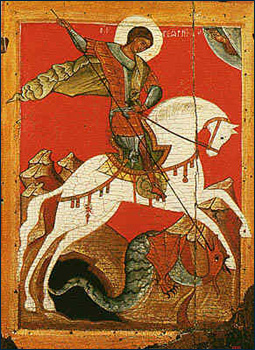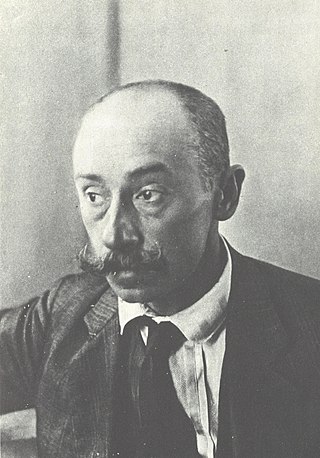
The Dnieper, also called Dnepr or Dnipro, is one of the major transboundary rivers of Europe, rising in the Valdai Hills near Smolensk, Russia, before flowing through Belarus and Ukraine to the Black Sea. Approximately 2,200 km (1,400 mi) long, with a drainage basin of 504,000 square kilometres (195,000 sq mi), it is the longest river of Ukraine and Belarus and the fourth-longest river in Europe, after the Volga, Danube, and Ural rivers.

Dnipropetrovsk Oblast, is an oblast (province) in simultaneously southern, eastern and central Ukraine, the most important industrial region of the country. It was created on February 27, 1932. Dnipropetrovsk Oblast has a population of about 3,096,485, approximately 80% of whom live centering on administrative centers: Dnipro, Kryvyi Rih, Kamianske, Nikopol and Pavlohrad. The Dnieper River runs through the oblast.

Ivan Konstantinovich Aivazovsky was a Russian Romantic painter who is considered one of the greatest masters of marine art. Baptized as Hovhannes Aivazian, he was born into an Armenian family in the Black Sea port of Feodosia in Crimea and was mostly based there.

Arkhip Ivanovich Kuindzhi was a Russian landscape painter of Greek descent.

Dnipro is Ukraine's fourth-largest city, with about one million inhabitants. It is located in the eastern part of Ukraine, 391 km (243 mi) southeast of the Ukrainian capital Kyiv on the Dnipro River, after which its name is derived. Dnipro is the administrative centre of Dnipropetrovsk Oblast. It hosts the administration of Dnipro urban hromada. Dnipro has a population of 968,502.

Among the collections of the Russian Museum in Saint Petersburg in Russia are some of the greatest pieces of Russian art in the world.

Luminism is a style of American landscape painting of the 1850s to 1870s, characterized by effects of light in a landscape, through the use of aerial perspective and the concealing of visible brushstrokes. Luminist landscapes emphasize tranquility, often depicting calm, reflective water and a soft, hazy sky. Artists who were most central to the development of the luminist style include Fitz Henry Lane, Martin Johnson Heade, Sanford Gifford, and John F. Kensett. Painters with a less clear affiliation include Frederic Edwin Church, Jasper Cropsey, Albert Bierstadt, Worthington Whittredge, Raymond Dabb Yelland, Alfred Thompson Bricher, James Augustus Suydam, and David Johnson. Some precursor artists are George Harvey and Robert Salmon. Joseph Rusling Meeker also worked in the style.

Konstantin Fyodorovich Bogaevsky was a Ukrainian and Russian painter from Crimea, notable for his Symbolist landscapes.

The Dnieper Hydroelectric Station, also known as the Dnipro Dam, is a hydroelectric power station in the city of Zaporizhzhia, Ukraine. Operated by Ukrhydroenergo, it is the fifth and largest station in the Dnieper reservoir cascade, a series of hydroelectric stations on the Dnieper river that supply power to the Donets–Kryvyi Rih industrial region. Its dam has a length of 800 metres (2,600 ft), a height of 61 metres (200 ft), and a flow rate of 38.7 metres (127 ft) per second.

David Johnson was an American painter, a member of the second generation of Hudson River School painters.

Arkady Alexandrovich Rylov was a Russian and Soviet Symbolist painter.

Filipp Andreevich Malyavin was a Russian painter and draftsman. Trained in icon-painting as well as having studied under the great Russian realist painter Ilya Repin, Malyavin is unusual among the Russian artists of the time for having a peasant background. It is possibly due to this that his paintings often depict peasant life, and his most famous work, Whirlwind, shows peasant women dancing.

Nikanor Onatsky Regional Art Museum in Sumy is a state museum in Sumy, Ukraine. Its collection is one of the best in Ukraine and contains works of native and from all over the world artists. It is a real treasure trove of national and foreign fine and decorative arts of the XVI - XXI centuries, based on the art collection of the famous Kyiv industrialist and philanthropist Oskar Hansen.

Realism was an artistic movement that emerged in France in the 1840s, around the 1848 Revolution. Realists rejected Romanticism, which had dominated French literature and art since the early 19th century. Realism revolted against the exotic subject matter and the exaggerated emotionalism and drama of the Romantic movement. Instead, it sought to portray real and typical contemporary people and situations with truth and accuracy. It did not avoid unpleasant or sordid aspects of life. The movement aimed to focus on unidealized subjects and events that were previously rejected in art work. Realist works depicted people of all social classes in situations that arise in ordinary life, and often reflected the changes brought by the Industrial and Commercial Revolutions. Realism was primarily concerned with how things appeared to the eye, rather than containing ideal representations of the world. The popularity of such "realistic" works grew with the introduction of photography—a new visual source that created a desire for people to produce representations which look objectively real.

Moonlit Night on the Dnieper or Moonlit Night on the Dnipro is an oil on canvas painting by Russian artist Arkhip Kuindzhi, from 1880.

Kuindzhi Art Museum was an art museum located in the city of Mariupol in Ukraine. It is dedicated to the display of the life and works of the artist Arkhip Kuindzhi, who was born in the city. The museum opened on 30 October 2010, but its creation was proposed almost a century earlier.

The Mariupol Museum of Local Lore is a museum of regional history in the city of Mariupol, Ukraine, at 20 Georgievskaya Street. The museum describes the natural conditions of the southern part of the Donetsk region and the history of the region from ancient times to the present. Its main activities of the museum are: Collection, exposition, research, scientific education and library. It was destroyed in 2022 during the Siege of Mariupol.

Evening in Ukraine is a painting by artist Arkhip Kuindzhi, painted in 1878. The painting is part of the collection of the Russian Museum, in Saint Petersburg.

Ukrainian Night is an oil on canvas painting by Russian artist Arkhip Kuindzhi, from 1876. The painting is part of the collection of the Tretyakov Gallery, in Moscow.

A Birch Grove is a landscape by the Russian artist Arkhip Kuindzhi (1842–1910), completed in 1879. It is kept in the State Tretyakov Gallery. The size of the painting is 97×181 cm. The canvas depicts birch trees growing in a sunny forest clearing. The unusual combinations of light and color and sharp contrast of sun and shadow create the impression of very bright sunlight. The upper part of the birches is not shown; only the trunks and small branches are visible, which stand out in light green against the background of the dark green forest. The composition is divided into two parts by a stream running through the middle.




















